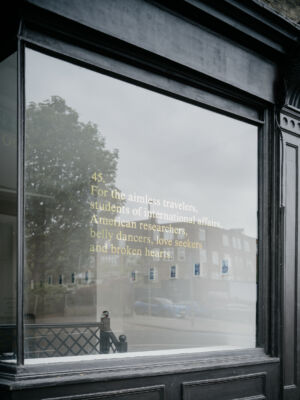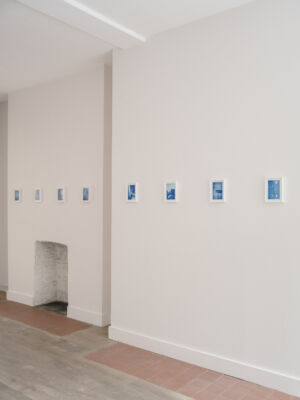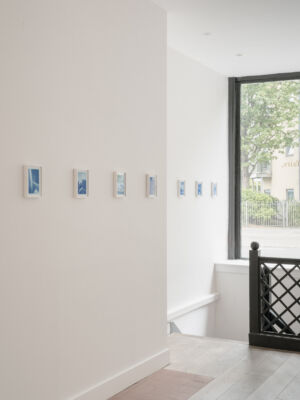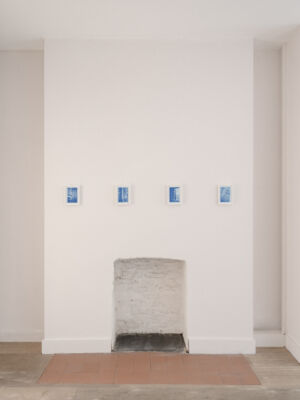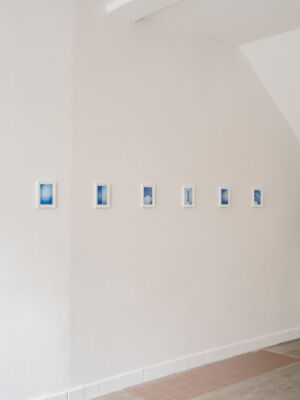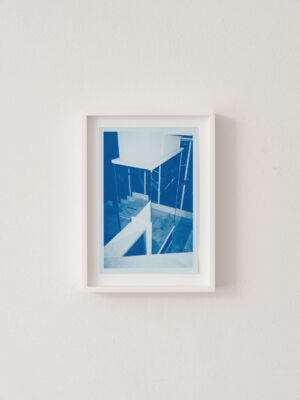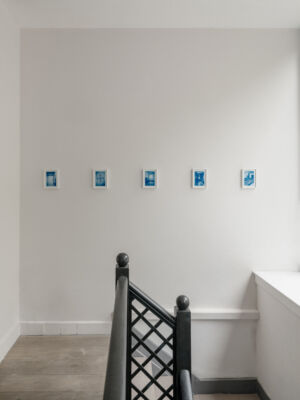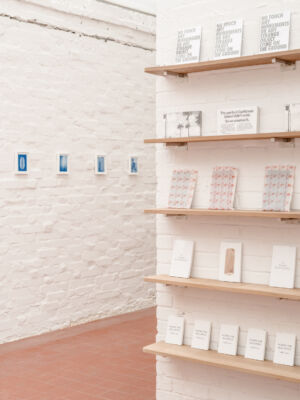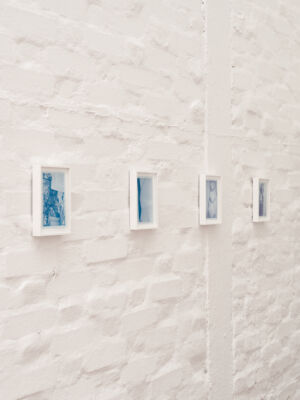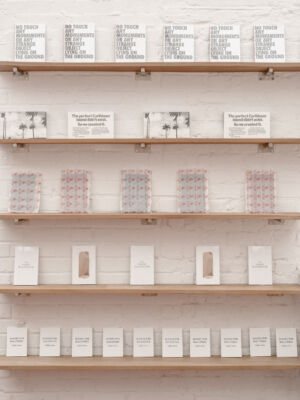Noha Mokhtar
‘No Nile View’
Curated by Gema Darbo
Presented by Apsara Studio
May 16th – June 15th, 2025. Apsara Studio, 200 Battersea Park Rd, SW11 4ND London
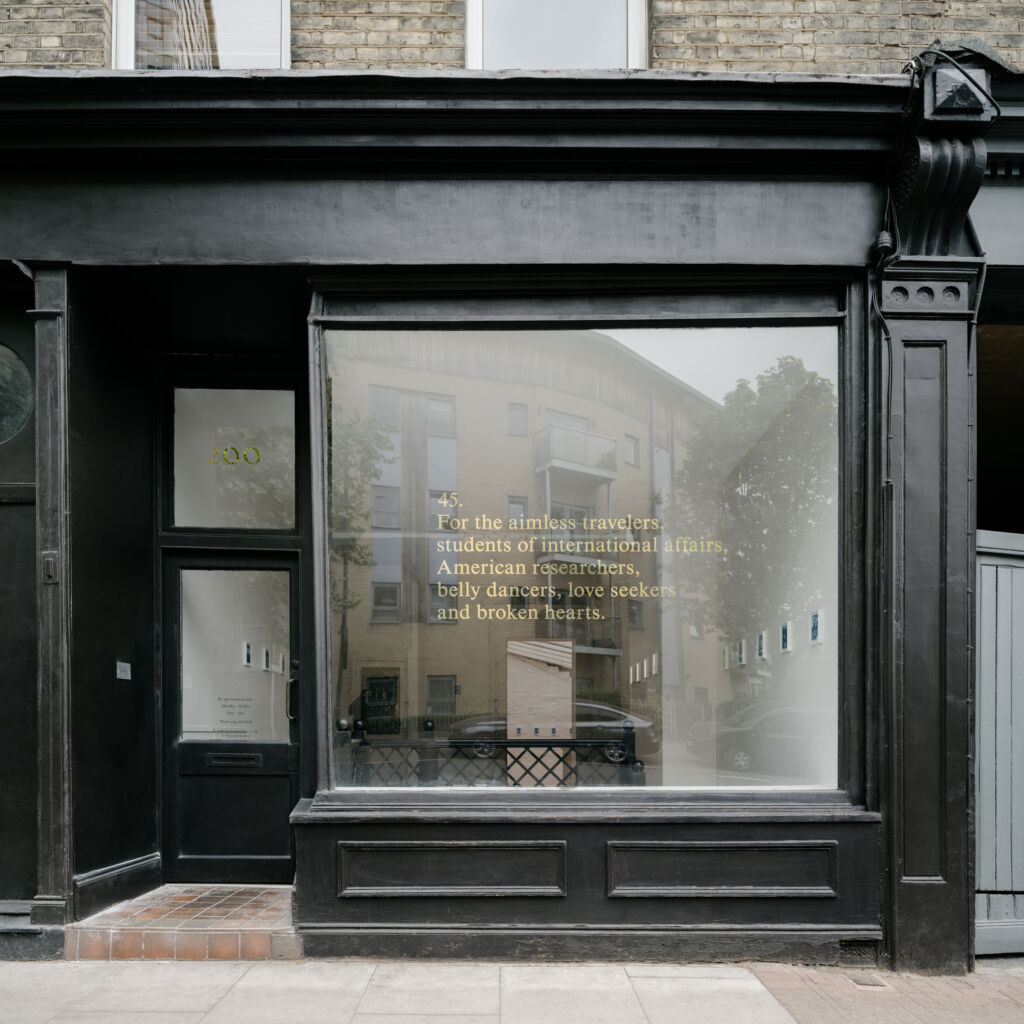
Noha Mokhtar, installation view ‘No Nile View’, 2025. Photography James Retief
Apsara Studio is pleased to present No Nile View, a body of work by Swiss-Egyptian transdisciplinary artist Noha Mokhtar, curated by Gema Darbo, associate curator and PhD candidate at Goldsmiths, University of London.
On view at Apsara Studio, Battersea Park Road, the exhibition offers an overview of Mokhtar’s speculative and generative practice. Her work is distinguished by its seemingly natural relationship between disciplines, where photography, ethnographic research and fiction writing are in an ongoing, fluid conversation. Currently a fellow at the Istituto Svizzero in Rome, Mokhtar’s exhibition is supported by the Swiss Cultural Fund and the Swiss Embassy, marking her first presentation in the United Kingdom.
In No Nile View, Mokhtar reimagines domestic interiors as speculative spaces, where traces of past lives linger and possible futures shimmer beyond temporal and spatial contours. Drawing its title from Mokhtar’s eponymous book co-authored with Gregor Huber, the gaze shifts away from the touristic interest in Cairo’s monumental landmarks to the confined interiors of middle and upper-class homes. Woven through an evocative and memorable visual narrative, at the heart of Mokhtar’s work lies the enduring question: what makes a home, home?
Presented as a sequence of photographs taken during a months-long search for housing in Cairo with Huber, the series begins as a form of visual note-taking. Fragmentary scenes of kitchens, hallways, bathrooms and living rooms, are initially captured by Mokhtar as registers of possibility: spaces once inhabited waiting to be lived in once again. But as the visits progress, the gaze gradually shifts, and the prospect of tenancy turns into an ethnographic attention to detail: the worn surfaces, the heavy curtains, the awkwardness of a built-in wardrobe. Over time, the images coalesce into loose categories, creating a composite of memories and surreal images that seem to depict the interior of a single imagined architecture, where dispersed fragments from different homes merge into one.
In this new iteration, the series is displayed in a single straight line across the two rooms of the gallery space. This linear pattern anchors a central viewpoint, offering the viewer a sense of stability and orientation. However, on closer inspection, the images appear rotated 90 degrees counterclockwise, leaving furniture and architectural features (such as ornate columns, coffered ceilings, balconies, and stained glass windows) subtly compromised. Within these altered interiors, Mokhtar suggests that domestic spaces reveal a latent exteriority, where windows covered by translucent foil become portals, and the thin gap between a built-in wardrobe and the wall becomes thresholds to non-specific worlds.
Mokthar’s photographic images are printed on offset blue carbon paper, creating a dense and textured atmosphere. Here, once freed from its original use for registration and duplication, the material has been repurposed into a translucent archive: sensitive to every mark and fleeting touch, the surface is imprinted with the traces of past lived experiences. Gaston Bachelard reminds us that placing memories in time is the task of the biographer, but placing them in space is what provides us with knowledge of our intimacy. In No Nile View, gestures of rotation, dislocation and imprinting open interstitial spaces that allow intimacy to emerge, rendering the familiar strange while opening the domestic sphere to evade enclosures.
On the gallery’s front window is a textual installation. Placed in dialogue with the blue series, a numbered quote recalls Mokhtar’s own years living in Cairo, when a house she inhabited became a passageway for temporary flatmates. The sentence is part of a set of printed captions accompanying each photograph. As readers move through the listing, Mokhtar suspends our assumptions: through the act of unnaming, the words open up an unexpected set of relations, weaving together personal memories, lived experiences, and the emotions these images evoke in her.
On the occasion of the exhibition, a selection of Mokhtar’s recent publications will be on display, many produced with Edition Hors-Sujet, an interdisciplinary publishing project founded in Zurich by Gregor Huber, Ivan Sterzinger, and the artist herself in 2020. On June 7, during the London Gallery Weekend, Mokhtar will present a performance followed by a conversation with Irit Rogoff moderated by Gema Darbo.
This exhibition is generously supported by:


Noha Mokhtar Interviewed by APSARA
We all want to know everything—On voudrait tout savoir!—but what a mistake that would be.
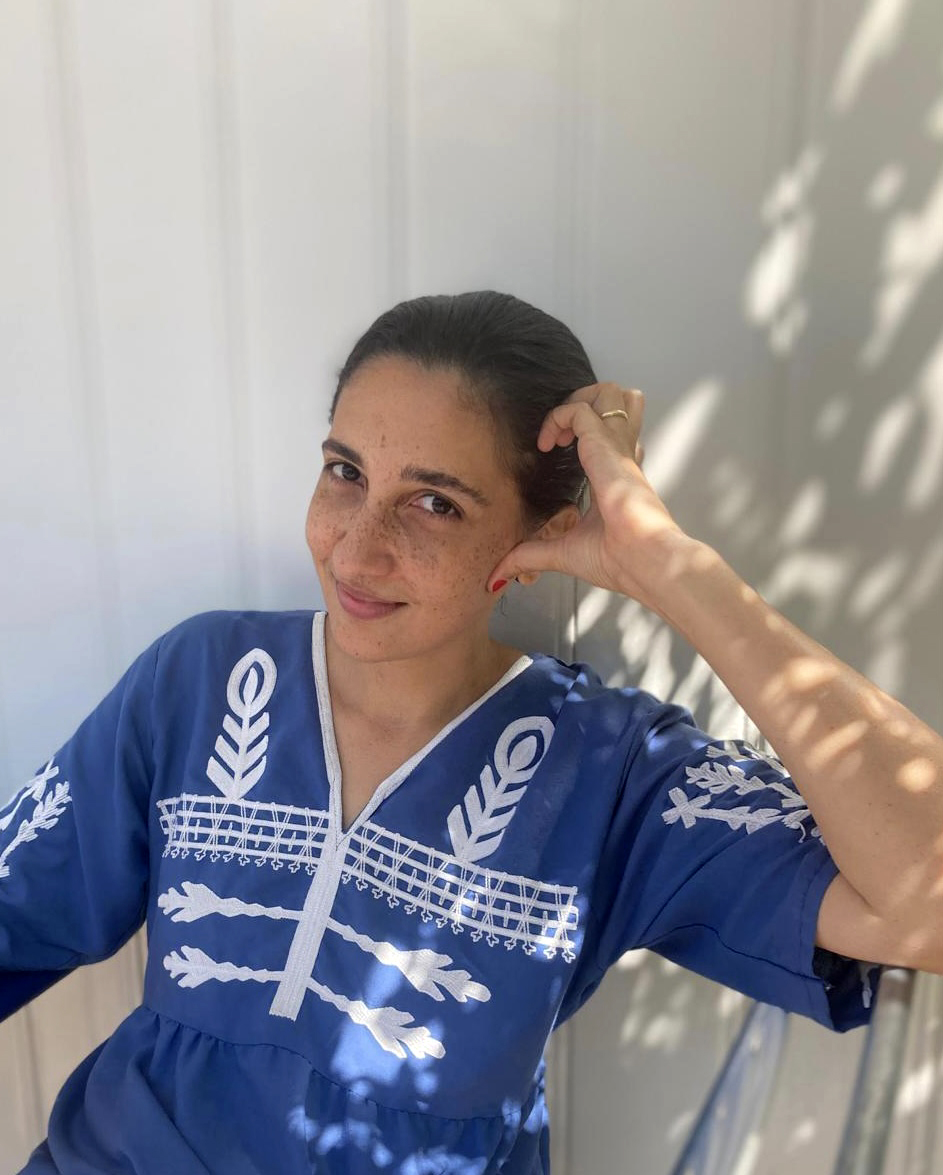
Noha, ´No Nile View´ is an evocative title. It kind of suggests a displacement in perspective. This work stems from a book of the same name, co-authored with Gregor Huber, where the notion of ‘home’ is central to it. However, in your work, this idea of home seems to be more speculative than offering a fixed definition. Can you tell us a bit about this?
I’m drawn to concrete, familiar, everyday things—a sofa, a Kleenex box cover, the outdated page of an agenda. I look at them until they begin to shift, becoming strange. In German, the word unheimlich captures this feeling: it comes from heim—the home—but also contains Geheimnis, secret—something familiar that should have remained hidden. We photographed homes in Cairo with this layered perspective in mind. At the time, Gregor and I were looking for a place to live—searching for a home. But we were also searching for the uncanny in them: the narrow gap between a wardrobe and a wall, forever unreachable. These apartments were filled with impressionable surfaces—carpets, walls, and ceilings that seemed to have absorbed all the dreams and memories. Some were our own, imagined in the act of choosing—what if we lived here?—and others belonged to those who came before or would come after.
Questions of domesticity, kinship and material culture are central to your research and practice. Your visual narrative style, blends disciplinary knowledge with personal observation, and this engagement with fiction and subjectivity. In which way this unveils your personal journey?
My approach often begins with close observation—attending to the everyday and the intimate. I do this not only as an artist and anthropologist, but also as someone shaped by multiple cultures, as an inhabitant of this planet, and as a mother. I intentionally blend perspectives and borrow from various fields because I’m not a specialist in any one area; I embrace the freedom of being an amateur. This allows me to cultivate a mode of attention that welcomes gaps and contradictions, and resists the urge for complete explanation, or control.
Your work navigates between fiction and non-fiction. What does this paradigm allow you to do within your practice that otherwise could not?
It allows me to delve into the layered nature of memory—how it shifts, fractures, and transforms over time. Much of my work springs from a personal place: a fragment of a story, a familial object, or a remembered space. I reimagine and reframe these experiences—not to conceal, but to make sense of them. It also invites me to embrace uncertainty, to work with “not knowing” or not knowing for sure. To play with possibilities, with maybes, rather than fixed certainties. We all want to know everything—On voudrait tout savoir!—but what a mistake that would be..
Since 2020, you have co-run Edition Hors Sujet t in collaboration with Gregor Huber and Ivan Sterzinger. A number of your works engage with this medium in a variety of modalities. Could you tell us about the role that publications play and what it enacts?
Sometimes a project begins as a book—a sequence of images unfolding over pages—and later transforms into an installation. Other times, it starts as a film and eventually takes the form of a book. The book might also be integrated into an installation, activating a sculpture, for instance, or entering into dialogue with a video on a screen. The space of the book and the space of the exhibition operate differently, each offering its own possibilities. But both are dynamic fields—sites for exploration and play. With Hors Sujet, we aim to explore these fields cross-medially and transdisciplinarily.
Noha Mokhtar lives and works between Zurich, Cambridge MA, and Cairo. She studied photography at ECAL in Lausanne and Anthropology and Middle Eastern Studies at the University of Bern. Currently she is pursuing a PhD in Social Anthropology and Critical Media Practice at Harvard University in Cambridge MA, where she conducts research on the relationship between architecture, kinship and materiality in contemporary Egypt. Her artistic practice includes photography, video, installation, as well as writing, and borrows from methods of ethnographic research. With projects oscillating between fiction and non-fiction, she seeks a critical engagement with notions of culture, family, gender, and the built environment. Mokhtar’s work has been exhibited at Haus Konstruktiv, Zurich; Centre d‘Art Contemporain, Geneva; Arts Santa Monica, Barcelona; Aargauer Kunsthaus, Aarau; Le lieu secret, Biel/Bienne; among others. Since 2020, ha run together with Gregor Huber and Ivan Sterzinger, the publishing initiative Edition Hors-Sujet.
Gema Darbo is a curator and doctoral researcher in Advanced Practices at the Department of Visual Cultures, Goldsmiths, University of London. Her research focuses on polycrisis as an infrastructural mechanism for rethinking curatorial approaches and modalities. She has taken part in long-term collective research initiatives such as Absent Audience (2020–2022), and worked as a research associate on Spectral Infrastructure, an editorial project by the collective freethought. She is currently associate curator at Apsara Studio, an independent contemporary art project space in London. Gema has collaborated with a range of cultural institutions, including Centre d’Arts Santa Mònica, Centre de Cultura Contemporània, and Can Felipa Arts Visuals in Barcelona; Centro Cultural Blanquerna and Matadero in Madrid; as well as Deptford X Gallery and Tate Exchange in London.She has been a curatorial resident in the UNIDEE programme at Fondazione Pistoletto–Cittadellarte in Italy (2024), and in the Matadero–LOOP programme in Spain (2022). She has delivered lectures at FAUNT, the Faculty of Fine Arts in San Miguel de Tucumán (2024), and at the Royal Danish Academy of Fine Arts in Copenhagen. In 2023, she also took part in Crear Situaciones: Arte y pensamiento colaborativo, an educational curatorial programme hosted by Centre d’Arts Santa Mònica. She holds a BA in Contemporary Photography: Practices and Philosophies from Central Saint Martins, and an M.Res in Curatorial Knowledge from Goldsmiths, University of London.
